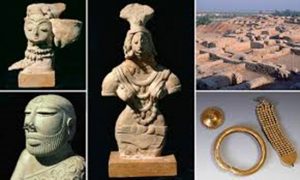Lakshmi Rameshwar Rao & Usha Aroor
The Indus Valley civilisation is the earliest and largest ancient known urban centers of the Indian subcontinent. It is also called the Harappan civilisation because Harappa in Punjab, now in Sindh Pakistan, was the first city to be excavated.
It was a Bronze Age civilisation, the historic period characterized by the use of bronze, proto-writing, (early writing systems) and other features of early urban civilisation.
This civilisation included two large cities, Harappa and Mohenjo-Daro, (Mound of the Dead) and more than a hundred towns and relatively small villages. Mohenjo-Daro, built around 2500 BCE, was one of the largest cities of ancient Indus Valley civilisation. it was one of the largest settlements of the ancient Indus civilisation or Harappan culture, with remarkable features such as standardised bricks, street grids, and covered sewerage systems. The people of this time developed the first accurate system of standardised weights and measures. Sculpture, seals, pottery and jewelry from materials, such as terracotta, metal, and stone have been excavated at the Harappa site.

Some of the cities had populations from 35,000 up to 50,000. These civilisations grew up on fertile plains that are good for cultivation. The cities got their grain from the villages or rural areas and soon had excess or surplus. Their lives were different from the lives of people in villages and that of people in earlier times. People practised different occupations and crafts.
Some of the settlements were large and some were fortified. Many people lived in these cities. Most of these city folks were not engaged in agriculture but were traders, soldiers, crafters, craftsmen or administrators. They produced different arts and crafts and knew writing.

Mohenjo-Daro was not only the largest city of the time but one of the world’s earliest urban centers. It was also one of the most sophisticated cities of the period, with advanced engineering and urban planning. Harappa was probably a fortified city. It is believed to have been home to as many as 23,500 residents living in sculpted houses with flat roofs made of red sand and clay. The city spread over 150 hectares to 370 acres, had administrative and religious centres of the same type used in Mohenjo-Daro. Excavations indicate that there was well-ordered wastewater drainage and trash collection systems, and possibly even public granaries and baths.

The city-dwellers were artisans and merchants grouped together in distinct neighborhoods. The quality of urban planning suggests efficient municipal governments that placed a high priority on hygiene and religious ritual. Individual homes drew water from wells, while waste water was directed to covered drains on the main streets.
Houses opened to inner courtyards and smaller lanes, and even the smallest homes on the city outskirts were believed to have been connected to the system, further supporting the conclusion that cleanliness was a matter of great importance.
It is unclear about how the Indus civilisation came to an end. By the middle of the 2nd millennium BCE, the city of Mohenjo-Daro was already dying and the final blow was probably delivered by invaders from the north. The civilisation’s southernmost parts seem to have continued until the Iron Age, around 1000 BCE.
By 1700 BCE many Indus cities had been abandoned. Historians believe things started to fall apart around 1900 BCE. This well-organised civilisation collapsed in just 200 years.Looking at the ruins we can see many changes. The cities became crowded, with houses built on top of houses. Important buildings like the Great Bath at Mohenjo-Daro were built over. People stopped maintaining the drains and they became blocked.

The Indus Valley Civilisation was first thought to be discovered in the early 1900s by a British archaeologist named John Marshall. Since then, archaeologists have uncovered more and more evidence of this ancient culture. Alexander Cunningham had come to Harappa in 1872 and identified a big mound of mud from which we have the name Mohenjo-Daro or “mound of dead”. In 1920 two archeologists D.R. Sahni and R.D. Banerji studied the sites. Mohenjo-Daro and Harappa are UNESCO heritage sites recently ravaged by floods.
(The writer has a Masters in Adult Education from Jamia Milia Islamia. She has many years teaching experience at the school level as also ten years of experience in book publishing and some published writing in newspapers and more students’ books. Lakshmi has retired and lives in Hyderabad.)





